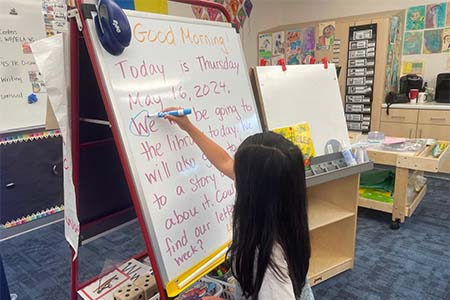Mornings in my Kindergarten classroom are more than just a way to start the day—they set the foundation for learning, connection, and success. A well-structured morning routine helps children feel safe, engaged, and ready to learn. It provides predictability, encourages social-emotional growth, and strengthens key academic skills. Through a Morning Message, Phonics Routine, Story Time, and Community Circle, my students develop early literacy skills, build relationships, and cultivate a love for learning. These moments are carefully designed to support both academic and social-emotional development, ensuring a positive and productive school day. Here’s how we begin each day and why each part is so important.
Morning Message: Building Community and Predictability
As soon as I enter the classroom, I see our Morning Message displayed on the board. This message isn’t just a greeting—it’s a way to help me and my classmates transition into the school day. The message often includes what we will be learning, a question to spark thinking, or a fun challenge.
Why is it important?
- Helps build predictability, which makes students feel secure.
- Encourages early literacy as students practice reading and recognizing words.
- Creates a sense of community, as students engage in discussions or answer the daily question.
A predictable routine like this helps young learners settle in and feel excited for the day ahead.
Phonics Routine: Laying the Foundation for Literacy
Right after morning work, we dive into our Phonics Routine. This is the time when we focus on letters, sounds, and word-building strategies that help us become strong readers and writers. We might practice letter sounds, segment words, or write high-frequency words on our whiteboards.
Why is it important?
- Phonics is the building block of reading and writing.
- Helps students decode words and improve fluency.
- Engages students with hands-on, multi-sensory learning like singing, movement, and interactive activities.
Research shows that strong phonics instruction is crucial for early literacy success (National Reading Panel, 2000). By practicing phonics daily, students develop confidence in their reading abilities.
Story Time: Expanding Imagination and Comprehension
One of my favorite parts of the morning is Story Time. My teacher picks a book, and we all gather together to listen. Sometimes, the book is from our curriculum—we might use stories from Benchmark Advance, Wit & Wisdom, Wonders, or other literacy programs. These books connect to what we are learning in reading, science, or social studies. Other times, we read a fun picture book just to enjoy a great story.
Why is it important?
- Develops listening comprehension, which is a key skill for reading success.
- Introduces students to new vocabulary and concepts.
- Helps students make connections between stories and their own experiences.
According to research from the National Early Literacy Panel (2008), early exposure to high-quality read-alouds improves children’s vocabulary, comprehension, and storytelling abilities. Story time isn’t just about listening—it’s about building a deep love for reading.
Community Circle: Strengthening Social and Emotional Learning
The last part of our morning routine is Community Circle, where we sit together, share our feelings, and connect with one another. We might discuss how we’re feeling, celebrate small wins, or do a fun greeting to start the day on a positive note.
Why is it important?
- Helps build relationships and a sense of belonging.
- Teaches social-emotional skills, like empathy and self-awareness.
- Creates a positive classroom culture, where every child feels valued.
Studies show that strong social-emotional learning (SEL) programs improve students’ attitudes toward learning and reduce behavioral issues (Durlak et al., 2011). When students feel connected and supported, they are more likely to engage and succeed in school.
Conclusion: Setting the Tone for a Great Day
Each part of my morning routine is carefully designed to support learning, social development, and emotional well-being. The Morning Message gets me thinking, Phonics helps me build literacy skills, Story Time lets me explore new ideas, and Community Circle helps me feel safe and ready to learn.
A strong start to the day leads to more focused learning, stronger friendships, and a happier classroom. And that’s why my morning routine is so important!
References:
- National Reading Panel. (2000). Teaching Children to Read: An Evidence-Based Assessment of the Scientific Research Literature on Reading and Its Implications for Reading Instruction.
- National Early Literacy Panel. (2008). Developing Early Literacy: Report of the National Early Literacy Panel.
Durlak, J. A., Weissberg, R. P., Dymnicki, A. B., Taylor, R. D., & Schellinger, K. B. (2011). The impact of enhancing students’ social and emotional learning: A meta-analysis of school-based universal interventions.

